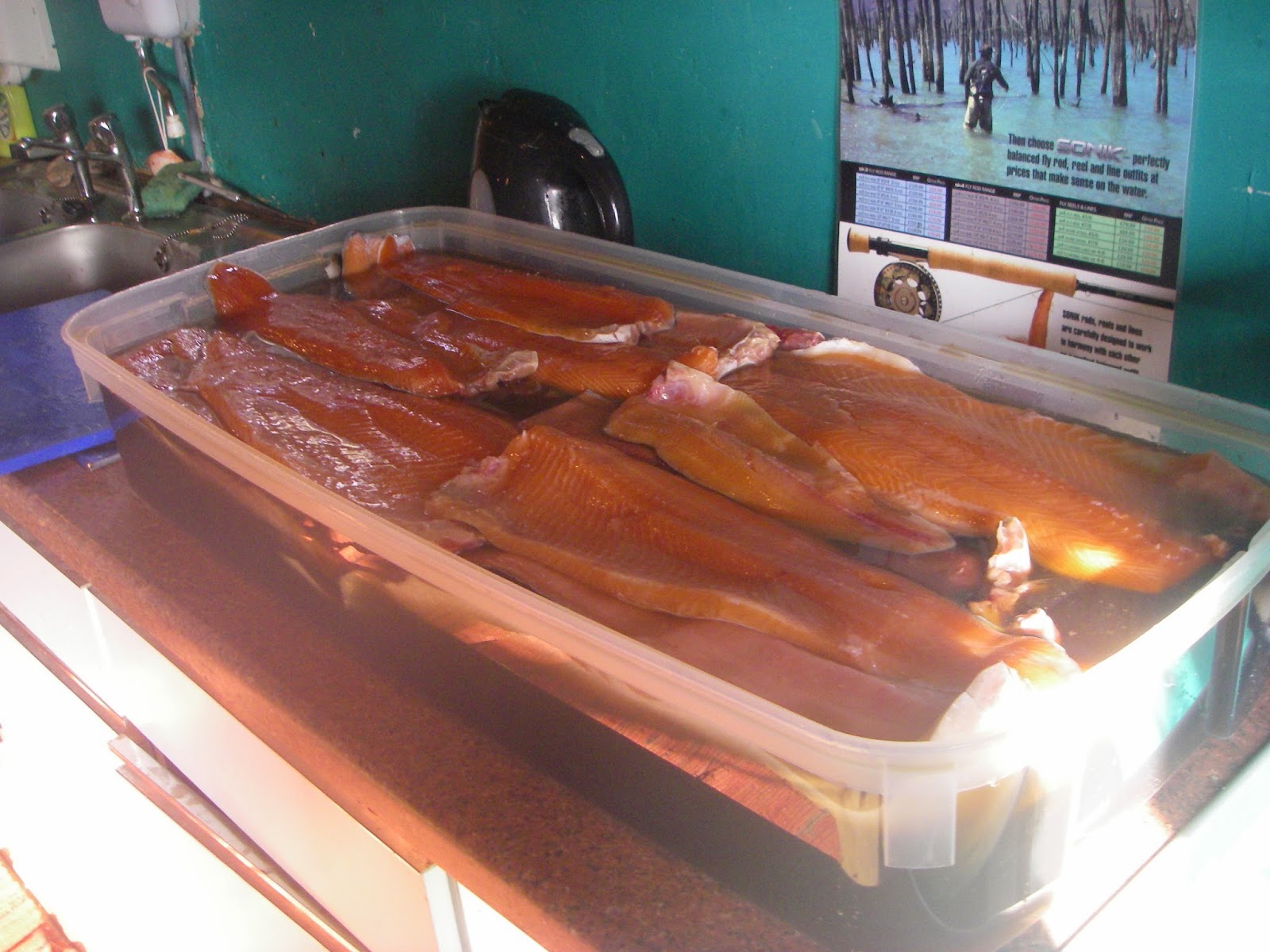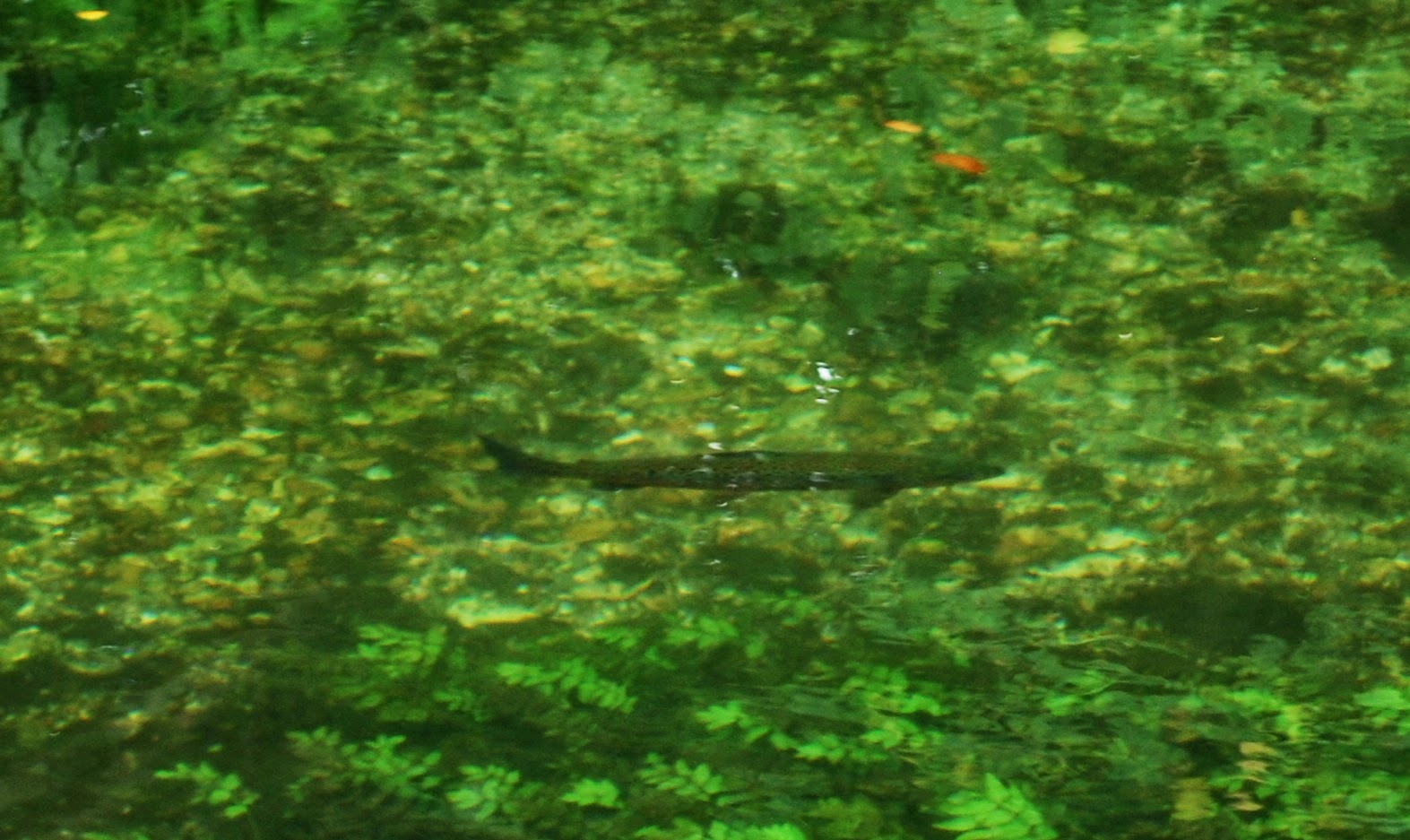Rutland FlyFishing Adventures … Cold Oak-Smoked Rutland Water Trout.
1) Get Some Great Trout from Rutland Water
The first thing is to use great ingredients. Rutland Water produces the best grown-on trout you can get. The lake is stocked each year with up to 80,000 trout. Mostly rainbows with a smattering of native brown trout at a minimum pound and a half up to 3 pounds. When these stock fish have been in the water a few weeks and realise what a food-rich natural environment they have been moved to, they start the naturalise and get as wild as it's possible to get within this populated island. Did I say wild? They're bloody furious when you hook them!
Well, when these trout have been in the lake for a year or more, they become a perfect specimen. Bright chrome silver, powerful 'spade-like' fins with mother of pearl translucent 'ribs' running down to perfectly sharp edges, and their flesh after eating a myriad of protein-rich natural food such as buzzers, nymphs, fry and pink shrimps, becomes rich orangey/red. No need for artificial colouring in our fish!
A big overwintered Rutland Rainbow is the best, around 3-5 pounds in weight, as wild as you can get, firm flesh, and deep red in colour. It's also excellent fun catching it in the first place. I give fishing lessons from my lakeside lodge, see www.rutlandwaterflyfishing.co.uk

2) Start the Curing Process
Prepare the brine solution. Dissolve as much salt as possible in a container add couple of 1 lb bags of brown sugar. The salt will take water away from the fish and start the curing process; the sugar gives a deeper colour and some extra taste, but not essential.
3) Fillet the fish, leaving the gill bone on (you’ll use this to hang it up with later). Try & leave as much flesh on as possible, you should be left with a ‘Tom & Jerry’ fish skeleton. You may have to trim the ribs off the fillet, some people pull out the tiny pin bones with a long nosed pliers. I don’t do this now, I’ll take them out before serving the finished fish. This is a time consuming business, so I tend to do fillets about 20 or 30 fish at a time. They’ll all freeze perfectly for months. You've got to do this in Winter, making sure that the fish doesn't 'cook' in the sun. Pre-Season, in dreary March is the best time to do it for me.
 4) Submerge the fillets in the brine solution (another way would be cover the fillets in dry salt with a mix of brown sugar) and leave in about 3 to 4 hours, depending on the size of fish.
4) Submerge the fillets in the brine solution (another way would be cover the fillets in dry salt with a mix of brown sugar) and leave in about 3 to 4 hours, depending on the size of fish. 5) Take out of the brine and wash off the salt solution. Leave to dry overnight.
 6) Smokin' !!! Make a hook for each fillet. An old wire coat hanger cut and bent into ‘S’ shapes is perfect and easy to do. Bend the 'S' shapes at a 90 degree angle so that the fish hangs vertically next to the next one along . Hang the fillets in the smoke cabinet.
6) Smokin' !!! Make a hook for each fillet. An old wire coat hanger cut and bent into ‘S’ shapes is perfect and easy to do. Bend the 'S' shapes at a 90 degree angle so that the fish hangs vertically next to the next one along . Hang the fillets in the smoke cabinet.  7) It’s important for the cabinet to be far enough away from the fire so that the smoke is cool as it percolates through your fish. I have 2 old filing cabinets, 1 on top of the other with a some piping taking the smoke on a ‘cooling’ journey before it gets to the fish.
7) It’s important for the cabinet to be far enough away from the fire so that the smoke is cool as it percolates through your fish. I have 2 old filing cabinets, 1 on top of the other with a some piping taking the smoke on a ‘cooling’ journey before it gets to the fish. 
 8) Put a container full of wood dust or fine shavings, any hard wood is OK but Oak is traditionally the best. Careful you don’t use too large shavings or they will catch fire, the idea is to produce smoke, not flames. I have a gas burner under a wire mesh pan, and as soon as the oak dust is smoking well, he’ll turn off the gas. 1 pan full takes about 3 hours to smoke through, then fill it up & start again. It’s a labour of love as fires have to be lit last thing at night and first thing in the morning and all through the day. It’s been known for me the light the fire through the night also!
8) Put a container full of wood dust or fine shavings, any hard wood is OK but Oak is traditionally the best. Careful you don’t use too large shavings or they will catch fire, the idea is to produce smoke, not flames. I have a gas burner under a wire mesh pan, and as soon as the oak dust is smoking well, he’ll turn off the gas. 1 pan full takes about 3 hours to smoke through, then fill it up & start again. It’s a labour of love as fires have to be lit last thing at night and first thing in the morning and all through the day. It’s been known for me the light the fire through the night also! 
9) How long to smoke it? How do you like your fish? I initially liked it strongly smoked, a perfect antidote to the bland, tasteless mass produced product you get in the supermarkets, if you do also, leave it in for about 4 days. It's a bit of an 'art' this bit, you get a feel for it. Nowadays, I prefer a light smoking keeping the natural flavour of these perfect, grown on Rutland trout, so maybe a day and a half is enough. It depends on the size of your fish and the density of your smoke.
 As you read this there are some lovely pink fleshed Rutland trout plus some rather large salmon from my expeditions to Scotland last year in the smoking cabinet. Plus I have a cheeky side or two of Zander. I know it's a controversial subject, but the taste of Zander is fantastic, so I'm trying a lightly smoked version, watch this space.
As you read this there are some lovely pink fleshed Rutland trout plus some rather large salmon from my expeditions to Scotland last year in the smoking cabinet. Plus I have a cheeky side or two of Zander. I know it's a controversial subject, but the taste of Zander is fantastic, so I'm trying a lightly smoked version, watch this space.  10) Unhook the fillets, trim off any excess bits, fins and the gill bones and leave to rest. It’s a bit too bitter a taste to use straight away, and develops nicely with time.
10) Unhook the fillets, trim off any excess bits, fins and the gill bones and leave to rest. It’s a bit too bitter a taste to use straight away, and develops nicely with time. 11) Coats each fillet with a bit of good olive oil, cuts some fillets into individual portions (I use them as a breakfast special 'Barnsdale Breakfast' delicacy at my 4 star Lakeside B&B on the water's edge here at Rutland Water), see www.thelodgebarnsdale.co.uk) seal in plastic bags and put in the deep freeze till you need some.
12) Eat it! Pluck the pin bones out. Thinly slice the trout. Drizzles some lemon, a drip of good virgin olive oil. A good grind of freshly crushed black pepper......... mmmmmm..... perfik! cheers everyone, Rob.
Rob’s recipes
Barnsdale Breakfast
Slice some Oak smoked Rutland Trout, pull out any bones, put on a cold plate and drizzle lightly with extra virgin olive oil.
Cut some small squares and strips of the trout and out in a pan with a chunk of butter and white pepper and a pinch of salt.
Put the pan on a low heat till the butter melts and the trout infuses into the liquid.
Add a couple of free-range eggs, your own are the best, the orange colour of ‘real’ eggs makes it a visual feast. Stir and stir, till it’s nearly cooked.
Add a teaspoon and a bit of crème fraiche, stir it in and add a bit more butter. This will make it so soft and velvety.
Toast 2 slices of Hambleton Bakery bread, any will do it’s all good, and leave to go crispy before lightly buttering it.
Arrange the toast on a plate, pour on the scrambled eggs and lay on the slices of smoked trout. Add a squeeze of lemon and a turn of fresh ground black pepper, serve with griddled tomato, and mushroom, garnish with a bright green sprig of parsley. …eh, be honest!!!! yum ☺
Home smoked trout on crackers/blinis/toast with the perfect dip
Make a creamy dip with crème fraiche, seafood sauce, extra virgin olive oil, cracked black pepper, a good squeeze of lemon and a hefty dash of horseradish sauce (this is a brilliant dip). Mix up and dollop on the cracker. Place some thinly sliced (not too thinly!) oak smoked Rutland trout. Add a tiny drizzle of the olive oil, squeeze of lemon and a turn of fresh milled black pepper, garnish with sprig of parsley…mmmm delicious, with some sharp, cold, sauvignon blanc.











































